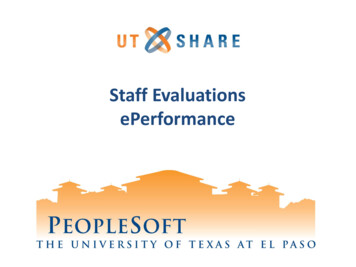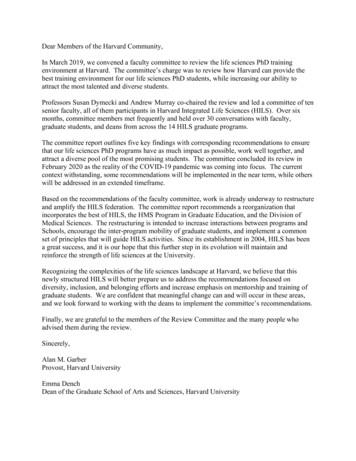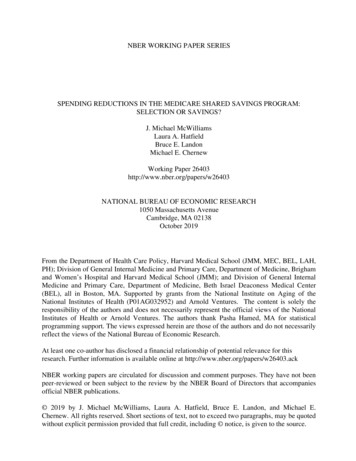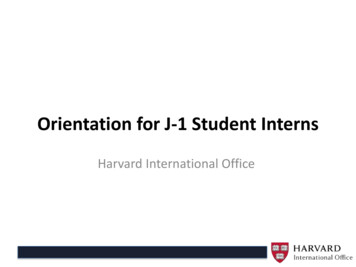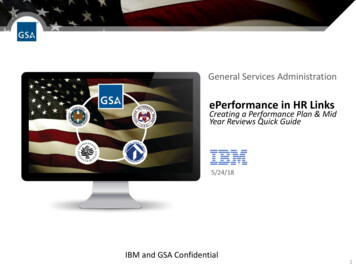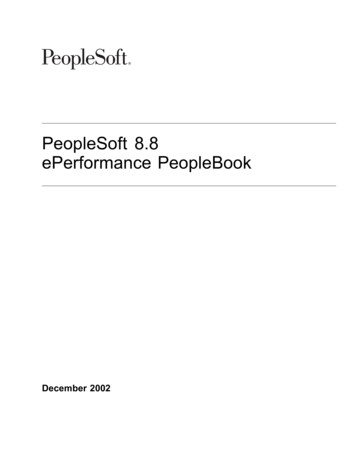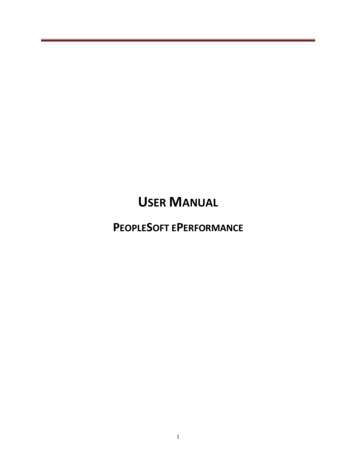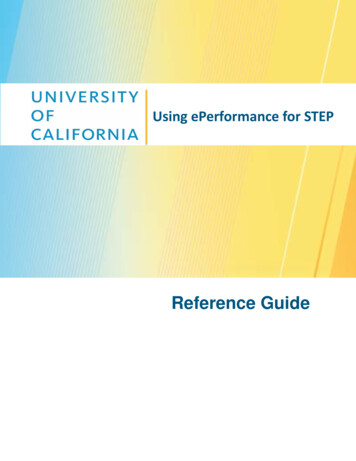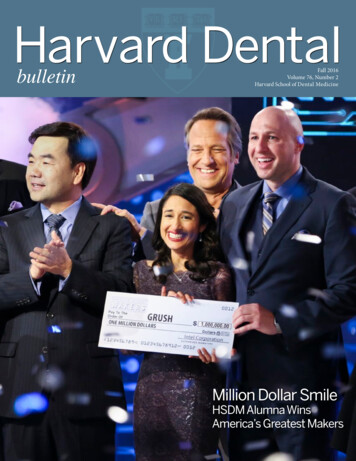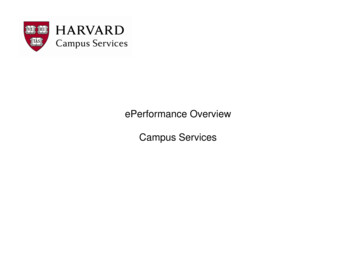
Transcription
ePerformance OverviewCampus Services
Talent Management:A Strategic Priority at Harvard A survey of our peer institutions shows that talent management is becoming a high priorityamong Universities Developing and retaining top talent has been highlighted as a risk in a recent CentralAdministration risk assessmentg gpulsepsurveyy results revealed that career planning/talentpg/managementgis The 2011 engagementa top engagement driver for employees
University Framework and Objectives Talent Management – an integrated approachAttracting and RetainingCritical Talent Workforce planning(i e succession(i.e.planning) RecruitmentDeveloping Employeeand Leadership TalentDriving WorkplacePerformance ProfessionalDevelopment PerformanceManagement Leadership/HighPotential Development Organizational Culture Retention– Performance Management is a critical step in the Talent Management strategy. It is thefoundation on which other pproducts are based (succession(pplanning,g, jobj descriptions,p,etc).
ePerformance at HarvardSchools and units agreed on common components for a University wide performancemanagement system: Organizational and individual goal setting Development Plan Competencies Self assessment by the staff member Manager assessment of the staff member Interim discussion (mid year check‐in) ptrackingg byy Human ResourcesConfidential review and completion Use of a common rating system which differentiates performance levels
What is ePerformance? Streamlines the performance management process into one Harvard‐wide, web‐based solution,solution creating a common employment experience across the University Fully integrates with core employee data and the talent management suite inPeopleSoft (learning and development, career planning, and succession planning) Allows all Harvard employees and managers to develop, review, and assess employeegoals and competencies required for their roles Allows all employees and managers to align their personal goals to University‐wideand School initiatives
Work to date and Timeline Sept 2012 ‐ Funding approved for ePerformance planning phase Sept 2012 – May 2013 ‐ University‐wide steering committee and Core planning teamwas established; weekly design and requirements meetings held Feb 2013 ‐ Funding requested for implementation June – Aug 2013 – Finalize requirements, begin implementation, initiate changemanagement Aug ‐ Sept 2013 – Communication and Training Sept/Oct 2013 – Go‐live (Phase I ‐ goal setting)
ePerformance at Campus ServicesWhat’s the same?Si il iti toSimilaritiest CS processAnnual work goals are established for employeesp yare assessed usingg competenciespEmployeesDevelopment Plan included in annual reviewF db k obtainedFeedbackb i d fromfothers:hOOptionalil goingi fforwarddUse of 5 point performance review rating scaleAbility for employees to complete a self‐evaluation during the PMP processAnnual timetable is similar
ePerformance at Campus ServicesWhat’s changing and improving?Changes/ Enhancements ‐ OverallIncreased efficiency/consistency – use of one tool to complete all assessmentsManager’s Dashboard – contains job/salary/performance information on direct reportsChanges/ Enhancements – Manager Dashboard The Manager Dashboard enables managers to quickly and easily view human resource information fortheir direct reports on‐line
ePerformance at Campus ServicesWhat’s changing and improving? (continued)Changes/ Enhancements – Talent Summary Managers will be able to view their direct reports’ talent summary information similar to what isdisplayed below
Competencies and RatingsAnnual ReviewOverall rating5‐ Leading Performance54‐ Strong Performance3‐ Solid Performance2‐ Building Performance1‐ Not meeting expectationsRating scale for Competencies:4‐ Advanced43‐ Proficient2‐ Developing1‐Does Not DemonstrateRating scale for Goals:MetPartially MetNot MetN/A10One Harvard Competency Dictionary: 31 competencies in the DictionarySchools can select a sub‐set and make themmandatory for their own employeesEmployees and Managers will pick additionalcompetencies from the list of 31 competenciesUniversity‐wide Mandatory Competencies forManagers: Teamwork and CollaborationEmbraces ChangeResource AllocationBuilding a High Performing TeamUniversity‐wide Mandatory competencies forEmployees: Teamwork and CollaborationInitiates Change
NewPerformance Ratings and DescriptionsPerformance RatingDefinition5‐ Leading PerformanceContributions have tremendous and consistently positive impact and value to the department and/or the organization.May be unique, often one‐time achievements that measurably improve progress towards organizational goals. Easilyrecognized as a top performer compared to peers. Viewed as an excellent resource for providing training, guidance, andsupport to others. Demonstrates high level capabilities and proactively takes on higher levels of responsibility.4‐ Strong PerformanceConsistently demonstrates high level of performance. Consistently works toward overall objectives of the departmentand/or organization. Viewed as a role model in position. Demonstrates high levels of effort, effectiveness and judgmentwith limited or no supervision.3 Solid Performance3‐Consistently demonstrates effectiveConsistentleffecti e performance.performance Performance is reflectivereflecti e of a fullyf ll qualifiedq alified and experiencede perienced individualindi id alin this position. Viewed as someone who gets the job done and effectively prioritizes work. Contributes to the overallobjectives of the department and/or the organization. Achieves valuable accomplishments in several critical areas of thejob.2‐ Building PerformanceWorking towards gaining proficiency. Demonstrates satisfactory performance inconsistently. Achieves some but not allgoals and is acquiring necessary knowledge and skills.For new employees: this rating can be used when an employee is still coming up to speed with their job duties asappropriate, based on their tenure in the position.1‐ Not meeting expectationsThe quality of performance is inadequate and shows little or no improvement. Knowledge, skills and abilities have not beendemonstrated at appropriate levels.
New Competency Ratings and Descriptions(for use by managers only)Rating4‐ Advanced3‐ Proficient2‐ Developing1‐ Does NotDemonstrateDefinitionHas broad and deep understanding and skills, with substantial expertise and experience in this area. Canapply this competency regularly and independently and display this competency in complex, variedsituations. Role model for this competency.Has sufficient understanding and experience to operate at a full professional level with this competency,and some practical application and experience. Exercises the skills in a broad range of moderately complexsituations. Can generalize basic principles to effectively function in both predictable and new situations.Newly developing in this area; has a general understanding of key principles but limited or no appliedexperience with this competency. Is capable of using this competency with coaching and support, insimple situations.Does not demonstrate this competency at the expected level, even with available assistance or directionfrom others.
New 360 Process and Questions Withh ePerformance,f360 feedback f db k questions are part off theh annuall review form;femployeesland managers can select assessors. 360 questions are completed by: Otherh Reviewers (peers/co‐workers/internal(/k /l Harvardd colleagues)ll) Direct/Indirect Reports (for employees that supervise at least one employee). 360 results are not shared directly with the employee. Results are viewed by the manager toh l iinformhelpftheh overallll performancefsummary andd rating.i Example of open‐ended questions for Other Reviewers: What does this employee do well? WhatWh shouldh ld thishi employeelstart doing?d i ? What should this employee stop doing? Managers have the ability to include additional open‐ended 360 questions for OtherR iReviewers.
New 360 Process ‐ Direct Report Questions Narrative and rated 360 questions will be included for Direct/Indirect Reports in the annualreview form. The questions are currently being vetted by HR Deans and Directors. Proposed topics for rated questions include: Communication Accountability & Development Workplace Environment & Teamwork Proposed narrative questions include: What are yyour manager’sgstrengthsg in managing?g g What are areas for improvement in his/her management style? Additional comments or specific examples of your manager’s effectiveness.
Training Delivery Methods(offered by CWD)Quick ToursOnline Help(in PeopleSoft)EEurekak‐Online Courses‐Job AidsWeb‐Ex”Ask the Trainer”Instructor‐Led‐LabsCampus Services Presentations‐local training delivery
ePerformance Transition – First Year Aug/Sep 2013 – Communication and Training Oct 2013 – CS goals are transferred to ePerformance Goals established in the June 2013 annual performance review willbe entered into PeopleSoft by employees Managers review and approve goals in PeopleSoft Jan 2014 – mid-year check-in April 2014 – 360 assessors selected May 2014 – 360 assessments completed May 2014 – self-evaluation completed June 2014 – annuall performancefreview completedld June/July 2014 – set goals for coming year
ePerformance at Harvard Schools and units agreed on common components for a University wide performance management system: . PeopleSoft (learning and development, career planning, and succession planning) Allows all Harvard employees and managers to develop, review, and assess employee goals and competencies required for their roles .
